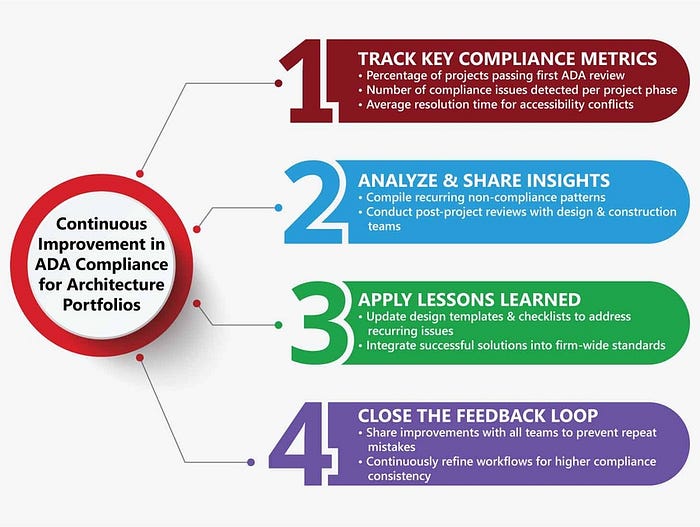Download — ADA Compliance Across Multiple Projects
Scaling ADA Compliance for Large-Portfolio Architecture Firms
The Americans with Disabilities Act (ADA) sets the legal framework for ensuring equal access to public spaces, facilities, and services for individuals with disabilities. In the architecture, engineering, and construction (AEC) industry, ADA compliance means integrating accessibility standards into every phase of project delivery, covering elements such as ramps, clearances, tactile signage, and restroom layouts.

Today, ADA compliance extends beyond physical spaces to include digital accessibility for building-related systems and interfaces, making it non-negotiable in both design and operations. For large architecture firms managing 100+ projects annually, the challenge lies in:
- Navigating varying federal, state, and local accessibility requirements
- Maintaining design consistency across geographically dispersed projects
- Preventing costly retrofits caused by late-stage non-compliance discoveries
This blog explores systematic, scalable approaches, including standardized templates, technology integration, and centralized review processes, to help large-scale firms enforce ADA compliance efficiently across an entire project portfolio.
Understanding ADA Compliance in Construction & Design
ADA compliance in the AEC industry is more than meeting a checklist-it’s about embedding accessibility into the DNA of every project. The ADA Standards for Accessible Design outline technical criteria that ensure buildings and facilities are usable by individuals with a wide range of physical and sensory abilities.
Key Accessibility Requirements in Design
- Accessible routes: Continuous, unobstructed paths with compliant slopes, widths, and landings.
- Doorways & clearances: Minimum clear opening widths, handle heights, and maneuvering spaces.
- Restroom accessibility: Grab bar positioning, turning radii, fixture heights, and stall dimensions.
- Tactile & braille signage: Placement, font, and contrast to meet ADA visibility standards.
- Ramps & curb cuts: Slope gradients, surface textures, and edge protection.
Applicable Codes & Standards
- ADA Standards for Accessible Design (U.S. Department of Justice) — Federal baseline.
- ICC/ANSI A117.1 — Technical specifications for accessibility in building design.
Federal vs. Local Variations:
While the ADA sets nationwide requirements, states and municipalities may have stricter or supplemental rules. Architecture firms must reconcile these differences early in the design phase to avoid conflicts, delays, or rework, especially in multi-state project rollouts.
A deep understanding of these nuances is essential for ensuring compliance at scale without compromising design quality or project timelines.
Read More : Residential ADA Checklist: A Step-by-Step DIY Compliance Guide
Challenges of Enforcing ADA Compliance Across 100+ Projects Annually
For architecture firms managing large-scale portfolios, ensuring ADA compliance across dozens or even hundreds of projects each year is a complex operational challenge.
Key Challenges of Enforcing ADA Compliance Include
- Variations in Local Codes & Interpretations: While ADA Standards provide a federal baseline, states and municipalities often impose additional requirements or adopt unique interpretations.
- Multi-Team & Multi-Partner Coordination: Large projects often involve multiple design teams, consultants, and contractors. Without centralized oversight, ADA compliance can become fragmented, leading to misaligned deliverables.
Addressing these challenges demands a systematic, portfolio-wide compliance framework-supported by standardized processes, real-time communication, and integrated technology-to maintain consistency without slowing delivery.
Download Project Phase-Specific ADA Compliance Checklists
Proven Strategies for Scalable ADA Compliance
Managing ADA compliance across a large project portfolio requires more than just awareness-it calls for standardized, technology-enabled, and process-driven solutions. The following strategies help architecture firms maintain consistency, reduce risk, and streamline compliance efforts at scale.
Standardized Design Templates & Detail Libraries
ADA Compliance Checklists
Dedicated Accessibility Review Teams
Regular ADA Training & Updates for Staff
Technology Integration
Key Advantages of BIM in ADA Compliance:
When applied strategically, BIM transforms ADA compliance from a manual review process into a proactive, automated design safeguard, saving both time and cost at scale.

Legal Risk Management for ADA Compliance in Large-Scale Architecture Projects
Effective ADA compliance isn’t just about design; it’s also about mitigating legal exposure through robust documentation and up-to-date policies.
Documentation Best Practices
Staying Current with Regulations
Quality Assurance & Site Verification for ADA Compliance
Key Practices for ADA Quality Assurance & Site Verification
A structured quality assurance workflow ensures compliance issues are caught early, reducing costly post-occupancy modifications and safeguarding legal defensibility.
Originally published at Download Project Phase-Specific ADA Compliance Checklists


Comments
Post a Comment